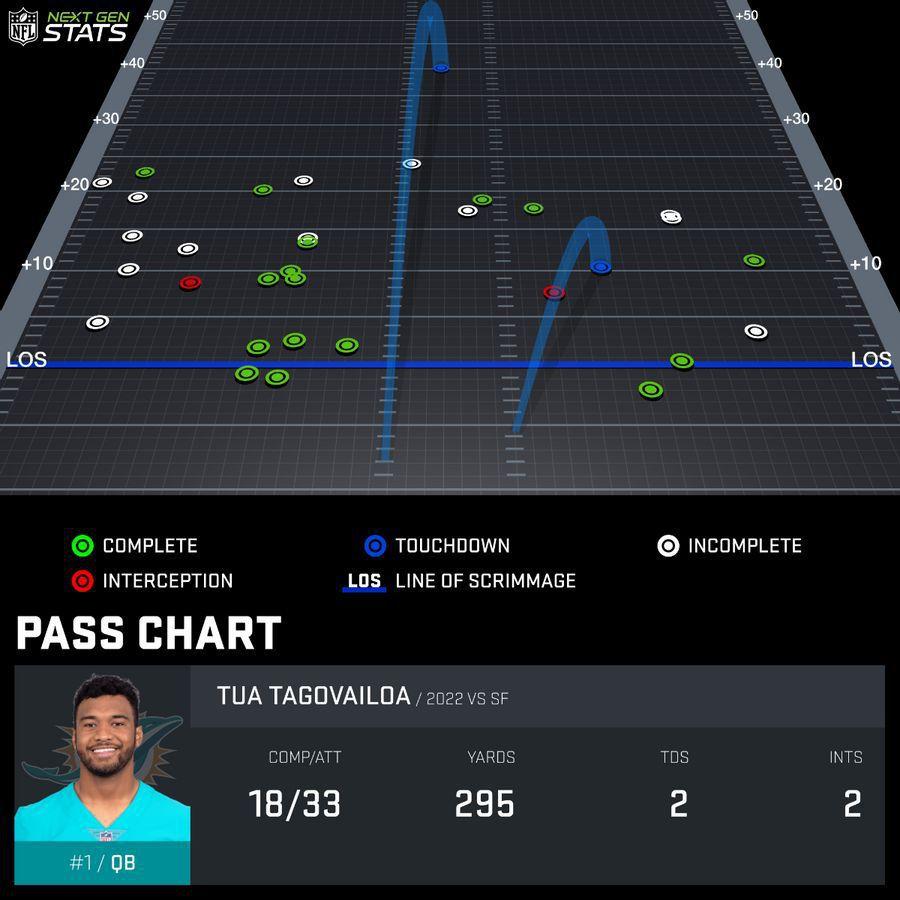Is There Really a Blueprint for Stopping the Dolphins? And if So, Can the Bills Use It?
After looking virtually unstoppable for much of the season, the Dolphins have lost two in a row and need to find some answers. Can they do so against Buffalo? Or will the Bills build on what the 49ers and Chargers have done and keep Tua and Co. searching?
Sunday night’s Chargers-Dolphins game did not go the way most experts and oddsmakers believed it would. Miami entered as road favorites, and with an already bad Los Angeles defense missing several key starters, including all-world safety Derwin James, it looked like it would be a high-scoring affair: The over/under was set at 55. That presented a mismatch on paper—the Dolphins’s nuclear-powered passing game, led by Tua Tagovailoa, Tyreek Hill, and Jaylen Waddle, seemed ready to run roughshod over the Chargers. But actually, the mismatch came somewhere else.
Miami managed just two touchdowns in a 23-17 loss. Tagovailoa completed 35.7 percent of his passes and averaged 5.2 yards per attempt, both season lows. Waddle was limited to two receptions for 31 yards. And while Hill found the end zone twice, one touchdown came on a ridiculous scoop and score:
This was the second consecutive week we saw a team completely stymie this offense, which had appeared unstoppable before the calendar flipped to December. In Week 13, the 49ers held the Dolphins to 17 points—seven of which came on a coverage bust on the very first offensive play—and forced three Tagovailoa turnovers. But that result wasn’t nearly as surprising as what we saw in Los Angeles the following week. San Francisco’s defense has hovered around the top five in EPA allowed and DVOA throughout the season. The Chargers, on the other hand, have been stuck at the bottom of the NFL’s statistical charts all year. Somehow both units were able to find the key to disrupting Miami’s offense: taking away the middle of the field, where Tagovailoa had previously been attacking with great success.
The NFL is known as a copycat league. If a certain tactic pays off, it doesn’t take long for the rest of the league to catch on. So with the Dolphins sputtering in two consecutive weeks, it seems there’s now a blueprint to stopping this offense that had been averaging 33.8 points per game in its previous four outings. And with a matchup against the Bills’ top-10 defense up next on Miami’s schedule, it won’t take long to see whether that’s true. Buffalo’s defense didn’t do so hot in the first game between these teams: Miami scored just 21 points, but that was because Buffalo held possession for over 40 minutes. Tagovailoa averaged 0.43 EPA per play that game, one of his best marks of the season, and the offense scored nearly three points per drive.
If there is a blueprint for stopping the Dolphins, the Bills defensive staff, led by head coach Sean McDermott and coordinator Leslie Frazier, will need to find it and put it to good use on Saturday night. And if Buffalo does, and hands Miami its third loss in a row, the Bills’ chances of winning the AFC East will jump to 99 percent, per FiveThirtyEight. A Dolphins win, meanwhile, would keep the divisional race open and would improve their playoff odds to 89 percent. This is the biggest game of the season for both teams—and will determine which of these teams is a true threat to Kansas City and Cincinnati in the AFC.
So that blueprint: Does it actually exist? What has really slowed the Dolphins down the past two weeks, and what can Mike McDaniel and his staff do to counter it?
Let’s start with the first question, and for an answer, we can go straight to Chargers coach Brandon Staley, who was asked after the game how much he had borrowed from San Francisco’s plan.
“They didn’t play pressed up like we did tonight,” Staley said. “They played quarters off [coverage] most of the time, or two deep, so their game plan was completely different from ours. Structurally, it’s not even close to being the same in the secondary. They use more of their linebackers to get it done, their pass rush.”
A review of the film backs up Staley’s comments. San Francisco defensive coordinator DeMeco Ryans didn’t deviate from his typical approach, rushing four and playing zone coverage, and he didn’t have to. With a defensive line capable of creating quick pressure, and linebackers, including super-duper-star Fred Warner, covering large swaths of grass, the sound 49ers defense could bother Tua and simultaneously close off the intermediate windows he had been exploiting all season.

San Francisco’s defense was talented and disciplined enough to survive this Dolphins offense using its base strategy. But Staley was at a massive disadvantage in the talent department. His Bosa brother (Joey) was out, and the team’s other edge rusher, Khalil Mack, hasn’t been the dominant player he was in Oakland and Chicago. Staley also doesn’t have a linebacker like Warner patrolling the middle of the field. So a more straightforward approach was never going to work.
Instead, Staley asked his corners to play aggressively in order to disrupt the timing of routes. On early downs, the Dolphins like to put Hill in motion to stress defenses, force the secondary to communicate on the fly, and get corners to back off. But the Chargers pressed up and played tight coverage, rarely giving Miami’s quick receivers room to breathe or build up speed. Sure, someone would eventually shake free, but that would force Tua to hold the ball and make difficult throws into cloudy windows.
“Don’t let fast guys run down the field,” Staley said of his strategy after the game. “When you let fast guys run down the field, as fast as they are, and you let them run through zones with no one around, then it’s going to turn into a track meet. And guess what? You’re not as fast as they are. No one is. … So if you want a chance, you got to get close to them.”
Miami hadn’t seen a lot of man coverage this season, especially on early downs, because it’s so difficult to get the matchups right with receivers streaking across the formation and swapping alignments before the snap. So the Chargers’ plan required excellent communication and built-in adjustments for whatever formation the Dolphins ended up in at the snap.
On later downs, Staley switched things up. The Chargers would often start in an alignment that screamed “man coverage,” with corners pressed up and linebackers acting as potential blitzers, only to drop into a soft Tampa 2 coverage after the snap. So far this season, the Dolphins have typically seen the inverse: zone on early downs and man coverage on third. That’s how NFL defenses generally play. Los Angeles flipped the script, and you can see the effect it had on Tagovailoa, who never looked comfortable in the game.
Staley threw changeups at the third-year pro, as well. Sometimes the Chargers would line up in a look similar to the one used on the Tampa 2 calls but then play man coverage with just one safety deep. And that’s where Staley really got creative: He wouldn’t actually have a traditional safety play that spot. Instead, he had his linebacker, Drue Tranquill, drop to the deep middle while his safeties pushed up to the intermediate areas to clog those windows.

That’s a changeup that would make Johan Santana jealous. Tranquill was dropping into a similar area on the Tampa 2 calls, so, to Tua, it all looked the same initially.
On the broadcast, it looked as if the Chargers were completely blanketing Dolphins receivers because Tua continuously threw to covered guys when there were better options elsewhere. Explaining why the offense didn’t perform well after the game, McDaniel scrutinized every position group, but also said that Tua could have done a better job “attacking a read that wasn’t necessarily primary in the progression.” Based on the film, it’s hard to disagree with that.
So I’m not sure there is really a book out on the Dolphins offense, other than make Tua uncomfortable, which applies to every quarterback/offense ever. The 49ers beat them with talent and discipline. The Chargers beat them with toughness and a bespoke gameplan that utilized Staley’s unique array of coverage tactics. I don’t think the other 29 teams out there are capable of replicating either approach in whole.
But that doesn’t mean Buffalo can’t learn from the two plans. Playing more press coverage, at least compared to the teams’ Week 3 matchup, would be a good start and help take away some of the concepts that gave Buffalo trouble in the first game.
And having Tre White and Jordan Poyer in the lineup after both missed that first matchup will be critical, and might allow McDermott and Frazier to call a more aggressive game. It should also help with pre-snap communication and post-snap teamwork given the chemistry this defense has built over the past few seasons.
“They are a fast, reactionary, trigger-ready unit that has played together a long time,” McDaniel said of the Bills defense on Wednesday. “So [they] know where each other should be and rely on each other, and really play to that team defensive philosophy.”
In a way, the Bills have the capability of playing like the 49ers while also utilizing some of the tactics that served Los Angeles so well on Sunday night. They have enough talent, especially in the front seven, and now they have the film of a defense that gave this offense problems in a way we hadn’t seen over the first 12 weeks of the season. Throw in some cold weather and a high chance of snow, and this could be the ultimate test of this capable but unproven Dolphins team.
It will also be a test of McDaniel’s ability to adapt, which is one of the keys to a successful head coaching career. That’s not to say the rookie head coach hasn’t provided his quarterback with opportunities these past two weeks—Tua has left a lot of meat on the bone—but, as he did early in the season, McDaniel will have to figure out new ways to gameplan around defenses that have a lot of film on his offense and know what knocks his QB off his spot. That’s the challenge that’s always facing these genius play-callers who prop up average to above-average quarterbacks: Eventually, you come across an overwhelmingly talented defense or a tailored game plan that takes away all the easy buttons you’ve created for the QB.
Over the past two weeks, Tagovailoa has been unable to find a reliable Plan B. If his coach can’t find one before Saturday night, this Dolphins season that started with so much promise will have an all too familiar ending for a fan base that has never seen its team win a playoff game in high definition.

